You’re probably well aware of the debate about which is “better”—real or artificial Christmas trees. Which one is better for the environment? Which is healthier and safer for kids and pets?
Unfortunately, there is no straightforward answer to the question. There are several different factors to consider, which will help you make the best decision for you, your family, and your home.
So to help you make your choice, I’m giving you the lowdown on everything you might want to know about potential environmental toxins in real and artificial Christmas trees. I’ll also give you suggestions on how to reduce your exposure and then some ideas for unconventional, hypoallergenic Christmas tree alternatives as well.
Keep scrolling and I’ll give you the details. But if you’re short on time, here’s the summary:
Here’s the TL;DR on Non-Toxic Christmas Trees in 2023
- Unfortunately, 100% non-toxic artificial Christmas trees do not exist.
- Most artificial Christmas trees are made out of PVC, which is one of the worst kinds of plastic. Better alternatives involve PE and/or PP.
- IKEA and Balsam Hill are two companies that offer PVC-free artificial trees. (The trees in Balsalm Hill’s “Most Realistic” collection are the ones that are almost entirely PVC-free.)
- Although it’s not possible to say that an artificial tree is completely free from lead, a PVC-free tree is much less likely to contain added lead.
- Most artificial Christmas trees contain flame retardants. IKEA says their trees don’t contain added flame retardants, but I don’t have a ton of confidence in their answers.
- Real Christmas trees that are grown organically and then composted afterward can be a better option for many people. However, they may not be the best choice for those with allergies and mold sensitivities.
- Whether you choose an artificial or real tree, there are things you can do to reduce your exposure to potential toxins, like simply washing your hands after decorating and wet-dusting your home regularly (+ more tips below!).
- There are lots of unconventional alternatives to Christmas trees — scroll down for ideas! 🎄
[P.S. Be sure to check out our guide to non-toxic, lead-free Christmas lights, natural holiday decorations, holiday family pajamas, organic gift ideas, non-toxic winter candles, and our holiday deals roundup! Or find all of our holiday/Christmas guides right here!]
Table of Contents
- Here’s the TL;DR on Non-Toxic Christmas Trees in 2023
- Are All Artificial Christmas Trees Toxic?
- 1. Polyvinyl Chloride (PVC)
- 2. Flame Retardants
- 3. Lead
- 4. Antimony Trioxide
- 5. What About PFAS in Christmas Trees?
- Are There Any Non-Toxic Artificial Christmas Trees?
- How to Reduce Toxin Exposure With Artificial Christmas Trees
- 1. Buy made in the USA
- 2. Look for a Prop 65 warning label
- 3. Wash your hands after handling and decorating
- 4. Keep your home clean
- 5. Use an air purifier
- Are Real Christmas Trees Safe?
- How to Reduce Toxin Exposure With a Live Christmas Tree
- 1. Go organic
- 2. Spray off your tree before bringing it inside
- 3. Keep your home clean and use an air purifier
- Are Real Christmas Trees Bad for the Environment?
- Unconventional Alternatives for Non-Toxic & Hypoallergenic Christmas Trees
- 1. Consider a Handcrafted Wooden Holiday Tree
- 2. Go for a Cardboard Christmas Tree
- 3. Buy or Make a Driftwood Tree
- 4. Use a Different Kind of Potted Tree
- 5. Use Books
- 6. Celebrate With An Outside Tree
- 7. Switch to Succulents
- 8. Decorate a Ladder
- One Last Note: Try not to get too stressed
- In Summary…
This post contains affiliate links, which means we may earn a small commission if you choose to make a purchase.
Are All Artificial Christmas Trees Toxic?
Unfortunately, pretty much all artificial Christmas trees contain toxicants. Here are the main chemicals we’re dealing with:
1. Polyvinyl Chloride (PVC)
Most fake Christmas trees are made from PVC, which is one of the most toxic types of plastic.
PVC contains chlorine. Chlorine creates byproducts called dioxins and furans—two chemicals that can be extremely toxic. According to the World Health Organization (WHO), dioxins “can cause reproductive and developmental problems, damage the immune system, interfere with hormones and also cause cancer.”
Not only that, but PVC almost always contains phthalates (which are used to make the plastic more flexible). Phthalates are endocrine disruptors, which means they can interfere with one’s natural hormone function and lead to infertility and developmental toxicity. They’re also linked to things like diabetes and asthma, and also may be carcinogenic.
What to Look for Instead of PVC: Polyethylene (PE) or Polypropylene (PP)
There are a few brands (like Balsam Hill and IKEA) that are beginning to reduce the amount of PVC in their Christmas trees by replacing it with polyethylene (PE) or polypropylene (PP). These types of plastic, although not perfect, are better than PVC.
(Not all of Balsam Hill’s trees are PVC-free. More info on how to find the PVC-free ones below.)
2. Flame Retardants
On top of the plastics, most artificial Christmas trees contain added flame retardants. Although the idea of flame retardants in our household products might initially sound like a good idea, research has found that they don’t actually do much of anything in terms of stopping or slowing the spread of flames, should a fire occur (at least in terms of furniture).
Although some recent legislation has been put into place that bans flame retardants from certain goods such as children’s products and upholstered furniture, most these laws don’t apply to artificial Christmas trees.
The chemicals used as flame retardants have been linked to a variety of negative health effects, including:
- endocrine disruption
- thyroid dysfunction
- cancer
- lower IQ
- hyperactivity
- altered sexual development
- neurodevelopment impairment
- fertility issues and other adverse pregnancy outcomes
Tiny flame retardant molecules can “off-gas,” or break off, your plastic Christmas tree and end up in the dust in your home. From there, these chemicals are breathed in and stored in our bodies, where they can potentially contribute to negative health effects.
This is especially true for children, who crawl around on the floor more (picking up dust particles) and have more hand-to-mouth contact.
In humans as well as in the environment as a whole, flame retardants are bioaccumulative and persistent, which essentially means that they stick around and build up over time. They are not easily “detoxed” from our individual and collective systems. This is why avoidance is especially important, when possible.
3. Lead
Most of us know that lead can do a lot of damage, especially to babies and young children. Even though U.S. laws involving lead in children’s toys, paint, and food have gotten stricter, the use of lead in plastic consumer goods has not been banned completely.
Does “PVC-Free” Also Mean “Lead-Free”?
Lead is actually used as a stabilizer in many kinds of PVC products, so the two toxins often come together.
Unfortunately, almost all artificial Christmas trees contain some amount of lead… the question is how much (and whether that lead is added intentionally or is a contaminant).
But one could assume that because of the fact that lead is often specifically added to PVC products, a PVC-free Christmas tree is likely to have less lead in it.
The state of California requires that any product that causes exposure to more than 0.5 micrograms of lead per day be labeled with a Prop 65 warning, so that’s one thing you can look to give you some more information about the tree.
Don’t be afraid to reach out to the tree company or manufacturer to ask whether or not they do independent, third-party testing to make sure that lead stays at a minimal level.
4. Antimony Trioxide
Antimony trioxide is a type of metal that’s carcinogenic. There are two main ways it get get into artificial Christmas trees:
- By being added to flame retardants to make them more effective.
- By being used in the manufacturing of PET plastic.
The flame retardant one is practically impossible to avoid… But when it comes to PET plastic, I would still say that PET/PE trees are still better than PVC ones. Evidence suggests that antimony may only leach from PET plastic at high temperatures, so unless your house is ~110 °F or more in the winter, it’s probably not leaching antimony from the PET/PE plastic. (For this reason, though, you may want to consider storing your tree in a cool place during the off-season if possible.)
Antimony trioxide is on California’s Prop 65 list, so this is another way that warning label can give you some more information about a specific artificial Christmas tree.
5. What About PFAS in Christmas Trees?
The last toxicant that could be present in your artificial Christmas tree would be PFAS.
(As a reminder, PFAS are those “forever chemicals” that make things resistant to water and oil—like Teflon, for example.)
The two main ways PFAS would get onto your tree would be either from contamination (most likely from machinery during the manufacturing process) and/or on the coating used to prevent the metal parts of the tree from weathering.
Unfortunately, at this time, it’s practically impossible to tell for sure whether or not your artificial Christmas tree contains PFAS or not, especially if it’s from contamination.
The good news is that there has been a lot of new regulation regarding the use of intentionally-added PFAS in consumer products in several states, so I think PFAS will steadily be phased out over the next decade.
Home
80+ Organic Gifts (for Adults, Kids, Teens, & More)
With 80+ ideas for natural & organic gifts, this guide will help you shop for your friends, colleagues, and loved ones, regardless of age, gender, or budget.
Are There Any Non-Toxic Artificial Christmas Trees?
Unfortunately, it’s really slim pickings when it comes to low-tox artificial Christmas trees… But here’s what I’ve got to offer you from my research:
IKEA (PVC-Free Artificial Christmas Trees)
For the 2023 holiday season, IKEA carries four full-sized artificial Christmas trees (ranging from $49 to $129), along with several different table-top trees.
They are made out of a combination of polyethylene, polypropylene, PET, and steel… So IKEA’s artificial Christmas trees are PVC-free.
Most of their trees are made out of partially recycled plastics, stating that at least 50% of the tree itself is recycled. In past years, I have seen some of their trees utilize sugarcane, which is a petroleum-free, plant-based plastic. In 2023, however, I so far have not seen anything indicating the use of sugarcane.
Similarly, I’ve seen information about the artificial trees having “no added BPA” in the past. But again, there’s nothing that detail seems to be missing this year. (It’s extremely difficult to determine whether or not recycled plastic is free from BPA or other bisphenols, anyway.)
Now, do IKEA’s Christmas trees contain flame retardants?
It’s really tough to say for sure…
In general, IKEA actually has pretty robust policies in place regarding flame retardants and PFAS. They banned intentionally added PFAS (aka “forever chemicals”) back in 2016. And they only use chemical flame retardants in areas of the world where it’s required by law, which is good news.
(If you’re interested in learning more, you can read our full breakdown of IKEA’s chemical policies here.)
Unfortunately, I have yet to be able to get a real, solid answer from anyone about the specific regulations for artificial Christmas trees and flame retardants. In recent years, there have been many state-based updates in flame retardant legislation in things like mattresses, upholstered furniture, children’s products, and electronics. But artificial Christmas trees don’t really fit into any of those categories…
Several years ago, I was told by an IKEA employee that their artificial trees do not contain flame retardants (FRs). I was told the same thing this year (2023) when I called and talked to a representative to try and verify this again… I’ll be honest, though, I’m just not as convinced as I used to be…
For one, the IKEA rep’s answer simply just didn’t leave me with a lot of assurance, and they refused to put me in touch with someone on the manufacturing side of things who could give me more detailed information. Second, I have been wondering why IKEA seems to be the only company I’ve been able to find over these years that doesn’t put FRs in their artificial trees…?
I also asked a lawyer to try and get some confident and current info about FR regulations for artificial trees for consumers, but was not able to get any solid answers. I’ve been in communication with Balsam Hill as well, in hopes they might be able to give me more information about specific FR regulations, but again have gotten nowhere. I’m going to continue trying to find some straight answers about this.
But in the meantime, regardless of the FR issue, if you’re going to get an artificial tree, I would still say IKEA is still one of the two best options because of the fact that they’re PVC-free.


Balsam Hill (Almost PVC-Free Christmas Trees)
Balsam Hill also carries some artificial Christmas trees, some of which are made almost entirely of PE and others that are made with PE + PVC. These, however, definitely do contain flame retardants.
To find Balsam Hill’s mostly PE trees, you can click here, and then under the “Realism” filter category, choose “Most Realistic.” The trees in their “Most Realistic” collection are the ones made with mostly PE. Balsam Hill has explained to me that the trees in this collection are made with “99.999999% PE”, but they do have a “PVC wrapping on the inner trunk and/or the very top of the tree, which is removable and for aesthetics only.”
Several other brands, such as Grandin Road, King of Christmas, and Birch Lane, also carry some trees that are made out of a blend of PVC and PE. But these, too, use flame retardants (and are not entirely PVC-free).
Always feel free to contact the company you’re thinking of purchasing from and ask for more information about the materials used to make their artificial Christmas trees. Sometimes you may need to contact them to find out exactly how much PVC is used.
As you can see, there’s no perfect, 100% non-toxic artificial Christmas tree. So, if you decide to go this route, keep reading to find out more about how to reduce the amount of toxins brought into your home by an artificial tree.

How to Reduce Toxin Exposure With Artificial Christmas Trees
If choosing an artificial tree turns out to be the best option for you, there are some things you can do to reduce your toxin exposure:
1. Buy made in the USA
Although “made in China” absolutely does not always mean “toxic” and “made in the USA” definitely does not always mean “safe,” products that are made overseas are more likely to be recalled due to lead contamination.
Try to look for trees that are manufactured in the USA or Europe, as the laws tend to be more strict regarding things like allowable levels of lead.
2. Look for a Prop 65 warning label
As I mentioned earlier, several of the toxicants that are found in artificial Christmas trees are included under California’s Prop 65 label, so looking for this label on your Christmas tree is one way to get a little more info.
3. Wash your hands after handling and decorating
Washing your and your kids’ hands after putting together and decorating your tree is another small way to reduce how many toxins you end up absorbing and ingesting.
4. Keep your home clean
As mentioned above, one of the primary ways flame retardants, VOCs, and other toxins are ingested by humans is through household dust. Tiny toxic molecules drift from your Christmas tree and into the dust, where it’s then inhaled by the people and pets in your home. So regularly wet dusting and vacuuming your house can help to reduce your and your family’s exposure. (Click here for some non-toxic cleaning product recommendations.)
Using a vacuum cleaner with a HEPA filter can help to capture the smallest particles, and using a robot vacuum can help you keep things clean while reducing the amount of work you have to do! Brands like Dyson, iRobot, and Eufy all have options with HEPA filters.
5. Use an air purifier
Indoor air pollution can actually be two to five times worse than outdoor air pollution. This is mostly because of all of the chemicals that we bring inside our home (not just Christmas trees, but furniture, paint, etc.). Once inside, the chemicals off-gas but then just sit there since there is so little airflow.
Using an air purifier like AirDoctor or IQAir can help to collect and trap fine particles and reduce indoor air pollution. Again, you’ll want to look for one with a HEPA filter if possible.
And if you get a warmer winter day, don’t be afraid to open up the windows and get some fresh air circulating!

Are Real Christmas Trees Safe?
So now that we’ve addressed artificial Christmas trees, the natural next question is: are real Christmas trees better?
The short answer is: probably… but it depends! What’s important is that you take all of the factors into consideration and make the best decision for you and your family. So let’s look at the potential toxins you might find in a real Christmas tree.
Pesticides & Herbicides
Trees that are grown using conventional methods can bring pesticides and herbicides into your home. These types of chemicals have been linked to everything from cancer and ADHD to infertility and Parkinson’s and more.
Doing a quick search for “organic Christmas trees in [your area]” can help you locate farms that are growing their trees using organic methods, without the use of pesticides and herbicides.
Mold
Real Christmas trees also have the potential to bring mold inside. Although many people can co-exist just fine with many types of mold, those with chronic inflammatory response syndrome (CIRS), multiple chemical sensitivity (MCS), Lyme disease, asthma, and/or other allergies or inflammatory conditions may want to take this into consideration when choosing what kind of Christmas tree is best for them.
Other Allergens
Those with allergies should also keep in mind that real evergreen trees can come with things like pollen and sap, which can potentially trigger sneezing, skin rashes, or other allergic reactions.
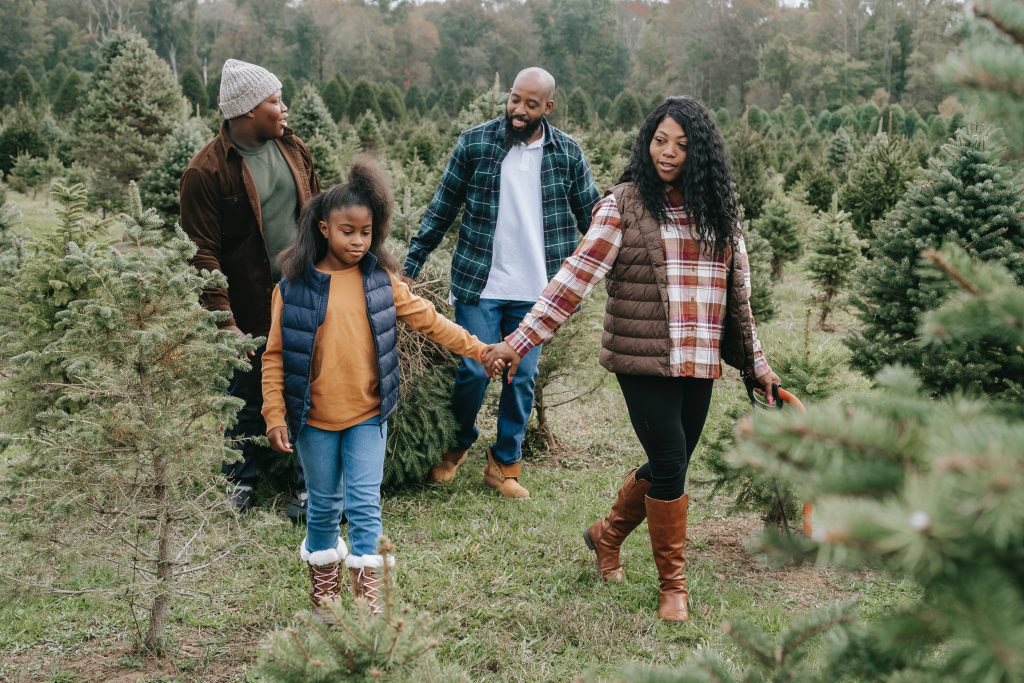
How to Reduce Toxin Exposure With a Live Christmas Tree
1. Go organic
Going with an organically grown Christmas tree is perhaps one of the safest options of all. Here is a (somewhat outdated) list of organic Christmas tree farms in the United States. Or you could just do a quick search for “organic Christmas trees in [your area].”
2. Spray off your tree before bringing it inside
If you do go with a conventionally grown tree, you may want to spray down your tree with the hose and let it air dry before bringing it inside. Although it’s not likely to get rid of all of the pesticide residue, it will help to reduce it.
3. Keep your home clean and use an air purifier
Just like with artificial trees, keeping your house clean of dust can help to decrease the amount of toxins and allergens you end up ingesting.
Are Real Christmas Trees Bad for the Environment?
There is, of course, another common question regarding Christmas trees: which one is better for the environment?
On one hand, an artificial tree seems like it could be more eco-friendly because it can be used year after year and it won’t contribute to deforestation.
On the other hand, fake trees are made from non-renewable, petroleum-derived plastics which will end up in landfills and never biodegrade. Real trees, on the other hand, not only help to capture carbon and contribute to healthy ecosystems as they grow, but they can also be composted at the end of their life.
Therefore, one of the most sustainable and eco-friendly options is to buy a real tree that was grown organically and harvested sustainably (and then compost it when you’re finished with it).
Here is our list of organic Christmas tree farms by state!
Home
A List of Organic Christmas Tree Farms (By State)
When searching for “organic Christmas tree farms near me,” you might have trouble finding what you’re looking for. We hope this list helps!
Another great option is to buy a potted or balled tree and then plant it in the ground after the Christmas season is over!
One more option that’s available in some locations is to actually rent a living Christmas tree. You can either pick up a balled tree or get one delivered and then send it back to the farm when the season is over where it can continue to live its life. Then you can rent the same tree the next year!
Home
2023 Guide to Non-Toxic, “Lead-Free” Christmas Lights
Do lead-free Christmas lights even exist? Here’s what to look for in safer, RoHS compliant string lights for the 2023 holiday season.
Unconventional Alternatives for Non-Toxic & Hypoallergenic Christmas Trees
If you or someone in your family is very sensitive to toxins and neither a plastic artificial tree nor a real evergreen tree will work well for you, there are still plenty of other out-of-the-box options:
1. Consider a Handcrafted Wooden Holiday Tree

One Two Tree is an eco-friendly Christmas tree that’s handcrafted from untreated high-grade Australian hoop pine. It’s easy to assemble, kid-friendly, and can be reused year after year.


Here’s another Etsy shop that’s based in Montgomery County, PA, and offers handmade wooden trees in several different styles and sizes.
They also offer different features and accessories. For example, you can choose whether or not your wooden branches stay still or are movable. You can also add a circular wooden base, a wooden star for the top, and/or a storage chest.
Or if DIY is more your thing, there are so many tutorials for different wooden trees. You can make your own wooden tree using timber dowels, make a flat wooden tree that displays your holiday cards, or just use paint and plywood.
2. Go for a Cardboard Christmas Tree

Cardboard Christmas is yet another Etsy shop that offers artificial trees made out of cardboard. Sizes range widely, from a tiny “pocket size” postcard tree ($14) to a life-size one (up to $440).
They are sturdy enough to hold plenty of ornaments and can be re-used year after year. They fold flat so they’re easy to store!
Or, you can make your own giant cardboard Christmas tree—it’s easy and cheap!
3. Buy or Make a Driftwood Tree

Similar to the wooden trees above, you can also get or make a tree made from reclaimed driftwood. These are really beautiful, and there are so many sizes and variations you can do. If you don’t have much space, you can get a smaller table-top tree, or you can hang one on the wall.
Or, instead of driftwood, you can just use regular branches from the forest—like this or this!
4. Use a Different Kind of Potted Tree

There are many varieties of trees that you can decorate during the holiday season and then enjoy as a regular houseplant during the rest of the year. Consider a fiddle leaf, a ficus, a bamboo tree, a citrus tree, a pine, or a palm.
The Sill has some quick and easy tips here and here.
5. Use Books

Clear off your bookshelf, stack your books into a pyramid, and decorate with lights and ornaments. There are so many different ways to make books into a beautiful tree shape.
6. Celebrate With An Outside Tree
If you want to stick with a real tree but can’t deal with the allergens, you might want to consider decorating a tree outside your home. If you have a spot outside of a main window, you can still enjoy the glow of the lights from inside! Plus, it can be fun to watch your tree slowly get a little bit bigger each Christmas.
7. Switch to Succulents

You can buy or make a beautiful tabletop tree made of real succulents, which will keep looking beautiful throughout the whole year.
8. Decorate a Ladder

Perhaps one of the most affordable options, you might be surprised about how pretty you can make a step ladder! Check out this tutorial from Funky Junk Interiors.
One Last Note: Try not to get too stressed
When you start paying attention to all of the toxins in your home, personal care products, consumer goods, and environment, it can quickly become pretty stressful! Try to remember that it’s not always about doing things perfectly, but rather focusing on what you can control by reducing exposure to toxins when possible.
Keep in mind that chronic stress can cause or contribute to long-term health conditions as well, which is obviously not what we want as we’re on this low-tox lifestyle journey.
Even though there may not be any “perfect” solution to non-toxic Christmas trees, try not to become too overwhelmed, and just do the best you can. I hope that this holiday season can be one of gratitude, rest, good food, and quality time with loved ones. When it comes to choosing a Christmas tree, just make the best decision you can for yourself and your family, and then relax and enjoy the season. 🎄
In Summary…
Most artificial Christmas trees are made from plastics like PVC and contain toxic additives like flame retardants. Real trees are a better option for many, but can come with things like pesticides, mold, and allergens like pollen. Buying a real tree from an organic and sustainable tree farm is one of the best options. Or, you can switch it up this year and consider one of the creative and unconventional Christmas tree alternatives listed above!
PIN IT:


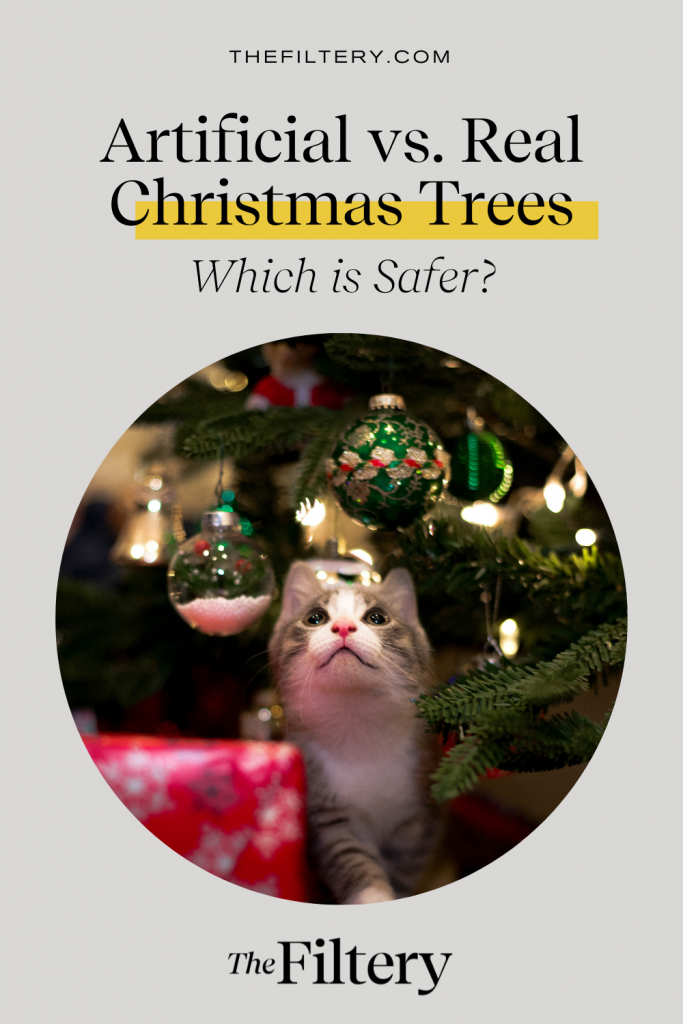


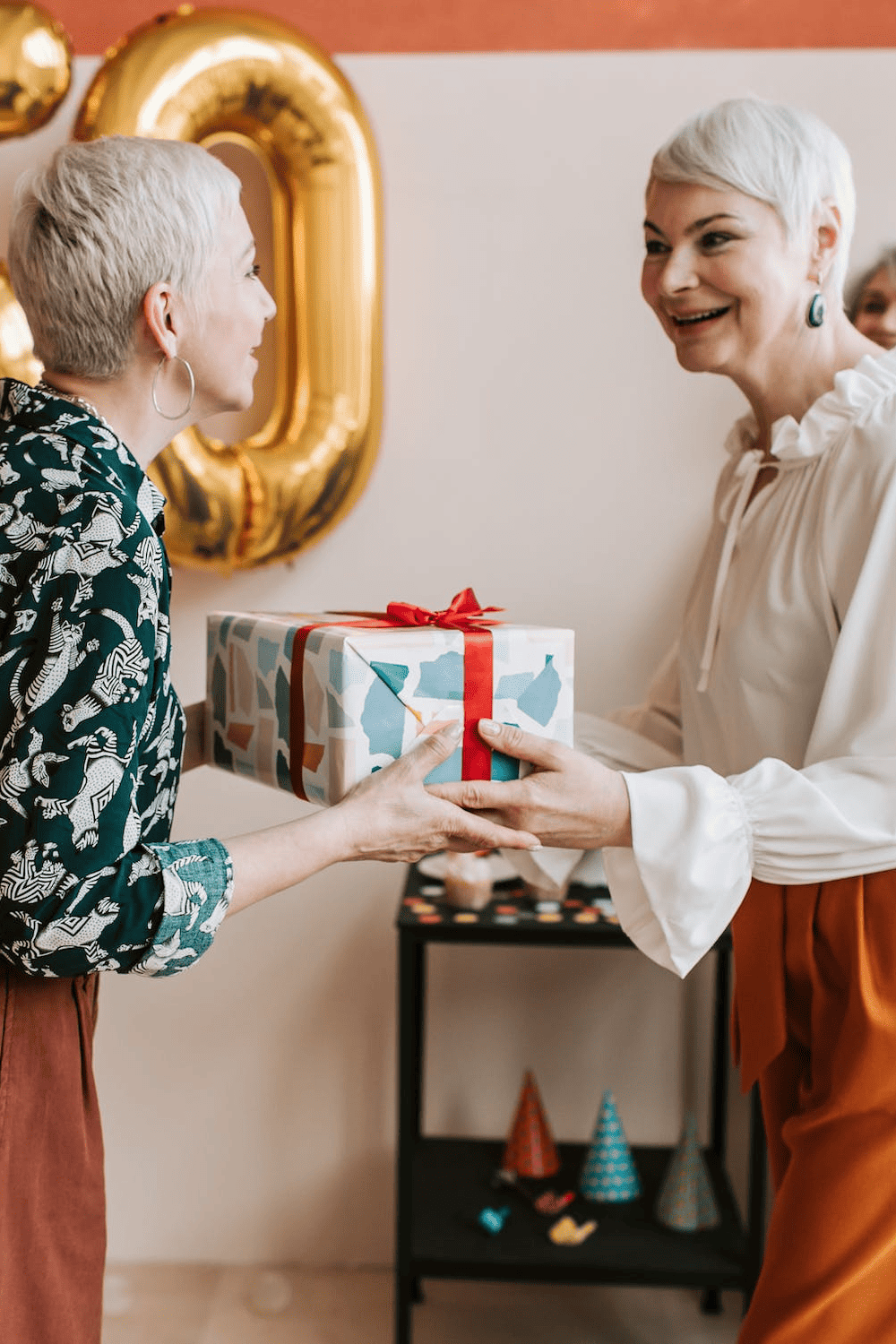


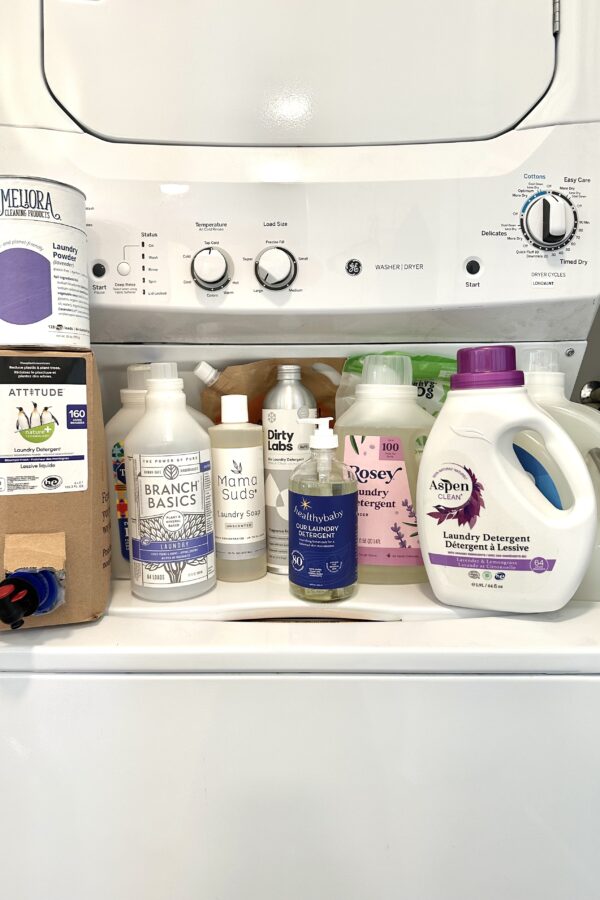
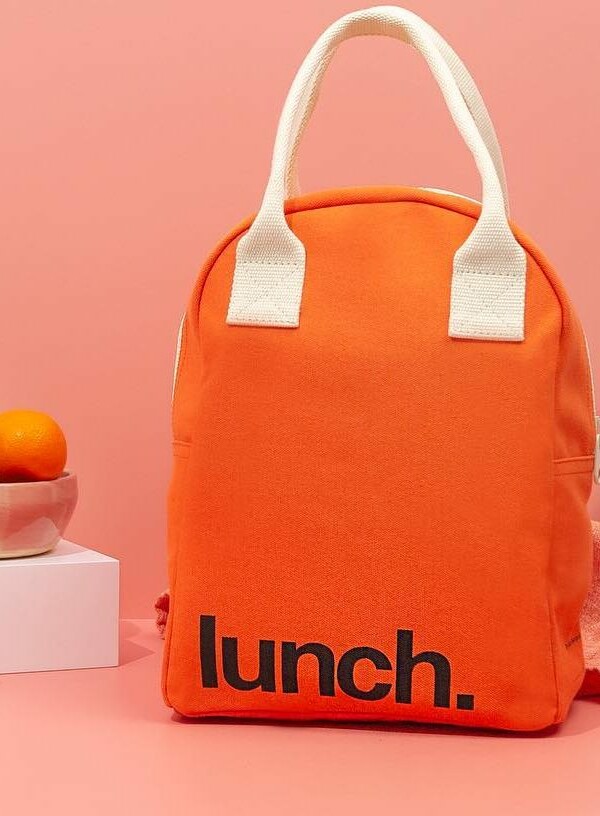
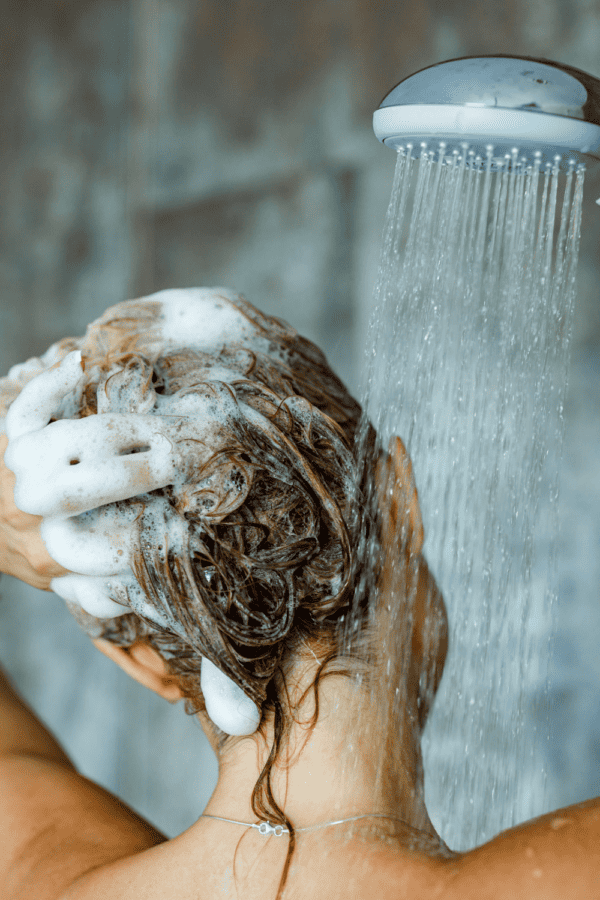
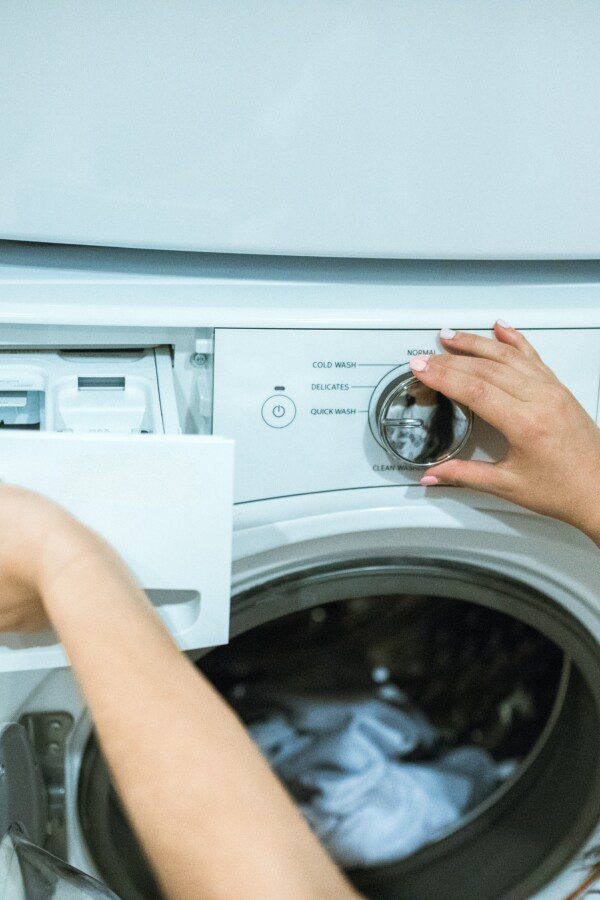
I want to thank you for publishing this incredibly helpful article. We just adopted a cat who loved eating the needles off of our old PVC holiday tree. It was only then that we started researching and realized how toxic those trees are. Just as we were losing hope that an all-plastic tree existed, we found your article and purchased the IKEA Vinterfint (82 3/4″). When our cat tried chewing it and realized she couldn’t get anything off of it, she was immediately disinterested. Success! Really appreciative of you taking the time to share this.
So glad to hear that, Becca! Thanks for sharing. 🙂
Does anyone know what month Ikea starts carrying their artificial Christmas trees for sale? I will need to make a trip a few hours away to go get one, but we’ve got an extremely mold sensitive kiddo so we can’t do a live tree anymore.
Your ideas are very useful. Actually one of my friends is planning to work in this field, so I’ll definitely recommend your post to him. Many thanks to you.
Hi there, I’ve been on the phone and chatting with Ikea for awhile trying to confirm this. Still no answers directly from anyone there…..did you get this information direct? Thank you.
Hi Kelly,
Yes, we confirmed with IKEA a while ago… You also may find this and this helpful!
Weird that PVC in artificial Christmas trees is so dangerous, yet PVC is what has and is currently use for many decades now for the plumbing in all of our homes.
I have personally experienced IKEA’s poor quality for their expensive wooden book shelves. The current consumer reviews show that IKEA has many poorly made products. So how much are you getting paid for this heavy endorsement?
Instilling fear to young parents with untruthful information is immoral.
Hi Susan,
I appreciate your concern. 🙂
– IKEA has never paid us a dollar. They’re not an affiliate of ours, so we do not get paid anything if someone makes a purchase through this article.
– Yes, PVC is used in much of our plumping, and this is something that many are concerned about. (https://grist.org/regulation/as-states-replace-lead-pipes-plastic-alternatives-could-bring-new-risks/). Just because a certain material or chemical is widely used in our society does necessarily not mean it’s safe (think: leaded gasoline, asbestos, etc.)
– IKEA’s products are not always the highest quality, but they are a much more affordable option for many people who have budget constraints.
– Our intention is never to fear-monger; it’s something that’s very important to us. This topic can certainly be scary & frustrating for some because of its nature. Our goal is not to scare people, but rather to give concerned folks actionable steps they can take to reduce their overall environmental toxin burden.
I found a tree on the Balsam Hill website that is 100% PE. They said they use Antimony Trioxide for their flame retardant. Do you think wiping the tree down or vacuuming it would remove some of the flame retardant? This particular tree doesn’t have a lot of needles so not as many nooks and crannies
Hi Courtney,
Vacuuming/wiping down the tree likely won’t remove most of the flame retardants, but it could help! If you’re going to get an artificial tree, you’re going to have to choose the “least bad option,” so at the end of the day, you have to make the decision that’s best for you and your family, and then try not to stress too much about it!
– Abbie